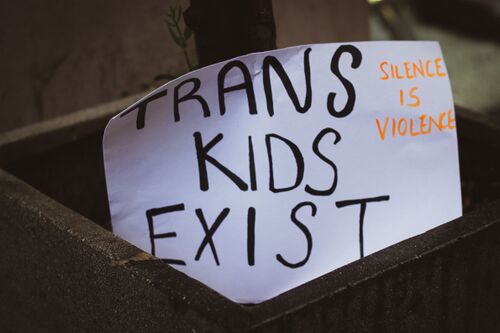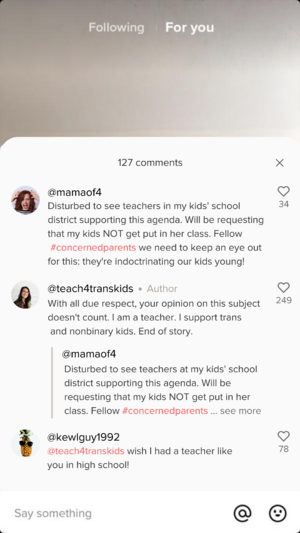Documentation:Digital Tattoo Curriculum/Case Studies for Student Teachers/Advocating for Equity, Diversity, and Inclusion
Theme
Teachers have the right to express their beliefs and support underserved students online, but they must also recognize that doing so might bring them attention, whether negative or positive, from community members.
In groups of 3-4:
1. Read the case study and consider your response to the personal reflection question as you read.
2. Discuss each question below with your group, using the resources to support your responses.
3. Take notes on your discussion to share when the large group reconvenes.
Personal Reflection
While reading the case study, consider your personal response to the following question:
As a teacher candidate, what is more important to me: expressing my beliefs online or maintaining a neutral online presence?
Case Study
**Content warning: this case study contains mentions of transphobia**
Lucia is math teacher at a high school where she has been working for the past year. She finally feels as though she is settling into the rhythm of life at her school, not only has she gotten to know her students and fellow teachers, she is now keeping up with the pace of of her teaching load and getting more comfortable in her role. However, as a queer woman of color, Lucia is frustrated by the lack of support that she sees for LGBTQ+ students at her school. In particular, she has noticed certain policies and rhetoric that might make transgender and nonbinary students feel uncomfortable and underserved at her school, including a particularly strict dress code which uses a gendered approach in determining what students are allowed to wear. Though Lucia is not a trans/nonbinary person, she firmly believes that being a part of the LGBTQ+ community means standing up for all of its members, especially those in vulnerable positions. For Lucia, it is clear that something must be done about this situation.
Though Lucia has been aware of this troubling dress code policy since the beginning of her time working at this school, she has not yet felt comfortable speaking up about the issue to the principal or other figures of authority due to her precarious position as a new teacher. Instead, she decides to provide some small level of support independently. Lucia makes a Tiktok account called “Teachers for Trans Students / @teach4transkids”. On this account, she posts educational content, information about current trans rights campaigns in schools, news, and supportive, affirming messages for trans and nonbinary students in short vieo posts. The account is linked to her professional Facebook and Instagram accounts, but she does not widely publicize this account to her school’s administration or fellow teachers due to trepidation about possible repercussions. However, many of her internet-savvy students have found and followed the @teach4transkids Tiktok account after looking up her Facebook and Instagram profiles.
“Teachers for Trans Students” gains a small following over the first few months until a short video that she makes featuring positive affirmations for trans students goes viral. The video features Lucia’s face, meaning that she is now easily identifiable as the owner of the account. This draws a lot of attention to her account not only from online strangers, but also from people in the local area. The vast majority of the attention that she receives is positive and supportive, but one parent from her school district discovers the account and makes the following comment about her affirmations video, to which Lucia replies:
Due to the attention from the parent, other parents in the district become aware that Lucia is behind the account. The majority of the parents that respond are supportive and positive, but Lucia receives several negative comments and direct messages, which she finds threatening and very disheartening.
The week after the post goes viral, Lucia learns that the parent who had posted the original TIktok comment has reported Lucia to the school board for her slightly less than courteous reply and for “promoting agendas that are contrary to family values”. The school board says that they will need to discuss this incident with Lucia.
Lucia feels very apprehensive about her upcoming meeting with the school board: she knows that she has done nothing wrong, but the school’s policies make her feel nervous that she is going to get in trouble with the administration and possibly face discipline. She is strongly considering pre-emptively deleting the account before her hearing, however, in the week leading up to the hearing, she receives positive feedback from many students, parents, and colleagues. The parent of one of Lucia's students starts a petition of support for Lucia and the @teach4transkids Tiktok account, which receives signatures from many people in the community. This petition gets passed out among Lucia's co-teachers, the majority of whom sign it. The head of the math department in particular stops her in the hallway to praise her efforts to support all students and states he will verbally support Lucia in the upcoming school board meeting.
Even more meaningfully, a student named Max visits Lucia in her classroom after school to discuss the Twitter account. Max thanks Lucia for making the account full of positive, affirming Tiktoks, saying that they had been struggling with their gender identity for some time. They share that knowing that they have a supportive teacher at school helped them to feel safe enough to come out as nonbinary to some of their classmates.
This conversation, the petition, and all the other support she has received leaves Lucia feeling more torn than ever: should she assert her right to keep the account due to the good it is doing for her students, or should she delete the account and try to avoid the possible repercussions that this incident could have on her career?
Discussion Questions
1. What would you do if you were in Lucia’s situation? Would you go about online interactions with parents differently than she did?
2. What do you think the role of teachers in online advocacy should be? Should teachers be neutral online, or should they speak up about topics they feel passionate about and support underserved students—at the risk of upsetting some parents, teachers, or school board members?
3. What impacts do you think the digital traces of this argument with a parent (and the messages of support and criticism that she received in its wake) will have on Lucia’s digital identity? How might this affect her career later down the line?
4. Do you think that online advocacy is an effective way of supporting students? Why or why not? What kind of outreach do you think is best for showing support for underserved students?
Additional Resources
If time allows, explore these additional resources:
- GLSEN: Supporting Trans and GNC Students
- Vancouver Secondary Teachers' Association: Professional Boundaries and the Use of Electronic Communication and Social Media
- National Association of Secondary School Principals: Social Media 101: Using Social Media to Advocate and Influence Policy
Sharing Permissions
|
|
When re-using this resource, please attribute as follows:
developed by the University of British Columbia: Digital Tattoo –
Case Studies Project Team.
Page view Statistics
This represents the number of times this page has been viewed since its creation:{{#googleanalyticsmetrics: metric=pageviews|page=Documentation:Digital_Tattoo_Curriculum/Case_Studies_for_Student_Teachers/Making_Noise_for_Marginalized_Students}}

